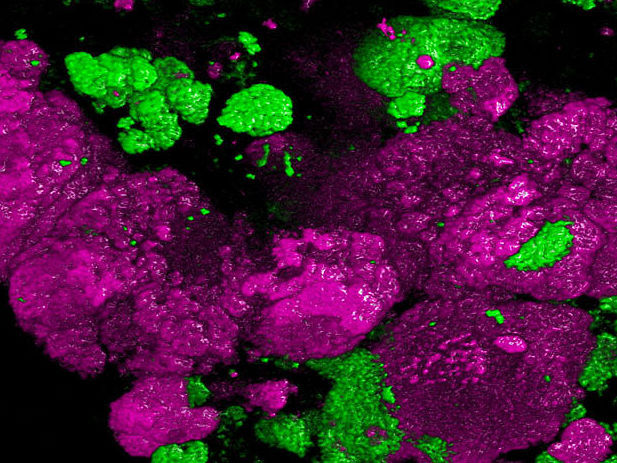Microbiologists Discover Enigmatic Comammox Microbes
New Chapter in Environmental Microbiology
Advertisement
nitrification plays a key role in Earth’s natural nitrogen cycle and in agriculture. This process comprises two sequential steps, and for more than 100 years experts have assumed these steps to be carried out by different microorganisms. Now an international team of scientists led by Holger Daims and Michael Wagner, microbiologists at the University of Vienna, has discovered microbes that perform complete nitrification on their own: A result contrasting textbook knowledge and a milestone of microbiology.

Cell aggregate of Nitrospira bacteria (pink) in activated sludge from a wastewater treatment plant. The colony contains several thousand Nitrospira cells. Colonies of other bacteria are depicted in green. The bacteria were visualized by fluorescence in situ hybridization.
Holger Daims
Nitrogen is a key chemical element for life and an essential nutrient for all living organisms. In particular, modern intensive agriculture totally depends on nitrogen fertilizers. However, fertilization with nitrogen compounds has its drawbacks. Following chemical conversion by nitrification, the nitrogen from fertilizers ends up in groundwater, rivers and lakes and disturbs the ecological balance in these waters. This problem is aggravated by additional nitrogen from domestic and industrial waste especially in countries that lack proper wastewater treatment.
Enigmatic Nitrification
Anthropogenic nitrogen deposition affects the natural nitrogen cycle where specific microorganisms convert nitrogen compounds. Among these microbes are the nitrifiers, which carry out the nitrification process where ammonium (a common nitrogen fertilizer) is oxidized to nitrite and, subsequently, nitrite is oxidized to nitrate. For 125 years, the two nitrification steps were known to be always catalyzed by different microorganisms: the ammonia oxidizers and the nitrite oxidizers, whose cooperation is required for complete nitrification. This textbook knowledge was the basis for hundreds of studies on nitrification in the environment and in wastewater treatment plants (where nitrification also is important). However, no microbiologist ever understood why labor is divided in nitrification. A single microbe capable of catalyzing both nitrification steps would actually benefit from conserving more energy. Microbiologists have coined a term to describe such a “complete” nitrifier: “comammox” (“complete ammonia oxidizer”). However, the existence of comammox remained an unresolved question for more than a century.
Surprise in a Russian Oil Exploration Well
A group of scientists led by Holger Daims and Michael Wagner, microbiologists at the Department for Microbiology and Ecosystem Science at the University of Vienna, has now solved the comammox conundrum together with cooperation partners from Russia, Denmark and Germany. The team analyzed a bacterial culture from a 1,200 m deep oil exploration well in Russia. Although this culture oxidized ammonia completely to nitrate, the only nitrifiers present were Nitrospira, so far known to be strict nitrite oxidizers. They could carry out the second step of nitrification, but any known ammonia oxidizers needed for the first step were absent. “This was an incredibly exciting moment. We assumed that this culture contained something new, but we did not expect the big surprise awaiting us” Holger Daims says. A complete genomic analysis of all bacterial species in the culture revealed the answer. “The Nitrospira bacteria possessed all genes for oxidizing both ammonia and nitrite, meaning complete nitrification. This seemed to be the long-sought comammox organism”, Michael Wagner adds.
Comammox is everywhere but was overlooked
Physiological experiments with the culture and a proteome analysis confirmed that the Nitrospira bacteria were comammox. Michael Wagner explains: “Nitrospira are well-known nitrite oxidizers that occur almost everywhere. The function as comammox of some Nitrospira was overlooked for decades”. Once the comammox Nitrospira had been discovered, the team was able to detect them in many soils, inland waters and in wastewater treatment plants. “This finding opens a new chapter of environmental microbiology” Daims says. “Our picture of the nitrogen cycle, which is essential for all life on Earth, was incomplete. Our next task will be to investigate more properties of comammox and its importance in nature and wastewater treatment plants.”
The findings of the microbiologists from the University of Vienna are published in “Nature” back to back with a study by colleagues from the Radboud University Nijmegen (The Netherlands), who also identified comammox Nitrospira. “The Nijmegen team is among the leading experts on the nitrogen cycle. When we learned by chance that both groups had made similar discoveries, we agreed to synchronize publication of our work to avoid an unnecessary race for the first paper”, Wagner states.
Original publication
Holger Daims, Elena V. Lebedeva, Petra Pjevac, Ping Han, Craig Herbold, Mads Albertsen, Nico Jehmlich, Marton Palatinszky, Julia Vierheilig, Alexandr Bulaev, Rasmus H. Kirkegaard, Martin von Bergen, Thomas Rattei, Bernd Bendinger, Per H. Nielsen, Michael Wagner; "Complete Nitrification by Nitrospira Bacteria"; Nature























































